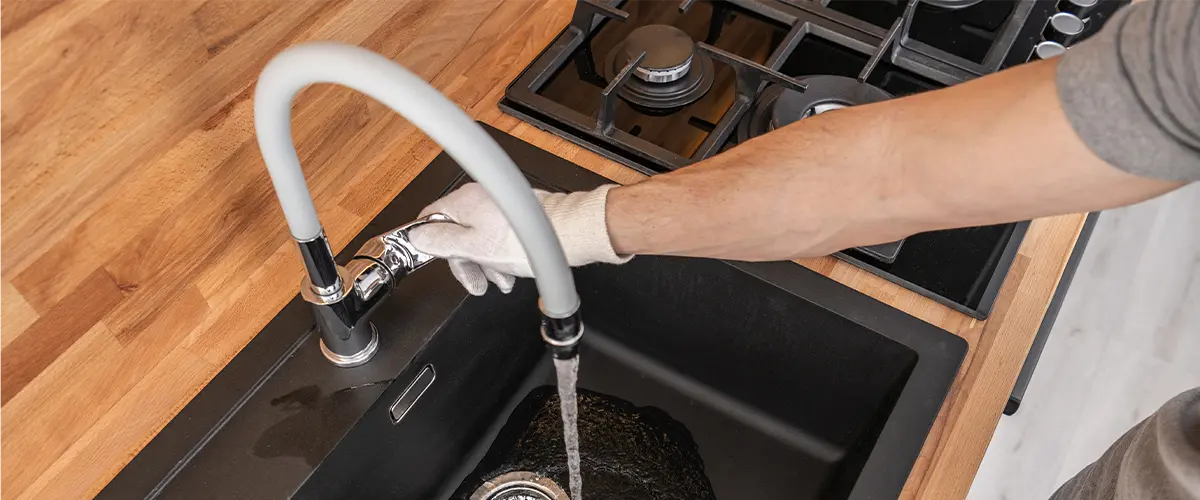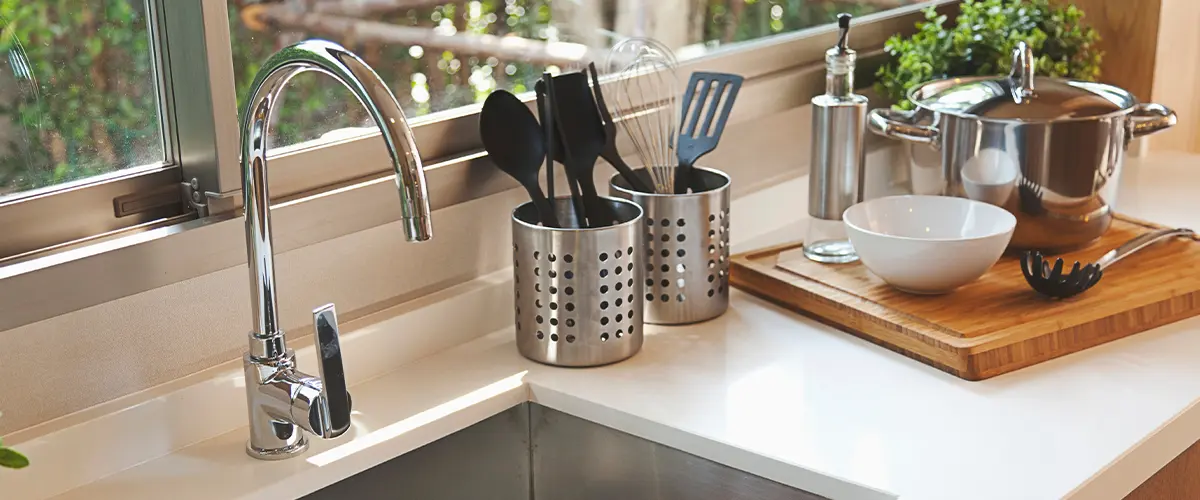Measure Your Sink Like a Pro
Measuring a kitchen sink can seem tricky if you’re planning a kitchen remodel or simply replacing an old sink. One surprising fact is that the correct size of your new sink greatly depends on accurate measurements of the existing sink and cabinet space.
This article guides you through how to measure a sink, ensuring you make no mistakes in choosing your next kitchen fixture. Get ready to measure!

Key Takeaways
- Start by gathering a tape measure, pencil, and notepad to note down the dimensions of your sink accurately.
- Clear everything out from under the sink and cabinet before measuring length, width, and depth for compatibility with new sinks.
- Understand your current sink type (top-mount, undermount, or farmhouse) as it influences how you measure and plan for installation.
- Measure the cabinet space carefully to ensure the new sink fits well without hindering plumbing or structural elements.
- Always check your measurements multiple times to avoid mistakes during purchase or installation.
Steps for Measuring a Kitchen Sink
- Gather necessary tools
Start with grabbing a tape measure, pencil, and notepad. These are essential for accurate measurements of your kitchen sink. Make sure the tape measure is long enough to span the entire length and width of your sink basin.
Use the pencil to mark key points if needed, and jot down all dimensions on your notepad. This step is crucial whether you’re looking at drop-in sinks, undermount sinks, or farmhouse sinks.
Next up, clear out any items from your current sink and cabinet area.
- Prepare the sink and cabinet
After assembling your equipment, your focus should shift towards the sink and cabinet. Completely clear the space under the kitchen sink. This step includes removing any obstructive plumbing pipes to make way for your measurements.
Light the area sufficiently to ensure visibility in all corners. Evaluate any existing damage around the cabinet section where the new sink will be placed flush or marginally below the countertop opening.
Afterwards, assess the positioning of your current sink in comparison to the countertop and cabinet space. If you are considering a top mount sink, observe its overlap with the counter.
In the case of undermount sinks, determine its attachment method under the countertop. Verify that there is ample space not just for the replacement kitchen sink, but also for possible faucet holes and extra features such as a drain or a sink grid.
Consistently inspect if there’s adequate space in the rear or surrounding area for needed electrical connections.
- Measure the sink's length, width, and depth
Once the sink and cabinet are ready, it’s time for precise measuring of your kitchen sink dimensions. Begin with the length, extending from the left edge to the right edge of what many sinks refer to as their upper edge.
This gives information on the lateral space your new kitchen sink will require.
Subsequently, discover the width by measuring from the front edge backward to its intersection with your countertop or wall. Make sure to perform this at both ends as all sinks may not have an entirely flat base or sides aligning perfectly with one another.
At last, determine the depth by taking measurements from the top downward to its deepest region in various locations because certain kitchen sinks might possess a minor slope at the bottom to promote efficient drainage.
These extra measurements are vital when searching for a new countertop compatibility or planning to upgrade with a drop-in sink or an undermount model which call for accuracy to attain that flawless appearance.
- Determine what type of sink you have
To determine the type of sink you have, check if the sink sits on top of the countertop (top-mount), hangs underneath it (undermount), or has a visible front surface (farmhouse/apron front).
This will help you understand how to measure and plan for installation. Pay attention to any unique features such as flat bottoms for undermount sinks or top edges for top-mount sinks.
Understanding your sink type is crucial before moving forward with measuring and planning modifications in your kitchen space to ensure a perfect fit. Now, let’s move on to measuring the cabinet space and cutout dimensions to complement your sink choice accurately.
- Measure the cabinet space and cutout
Measure the cabinet space and cutout to ensure a proper fit for your sink. Use a tape measure to determine the width, depth, and height of the cabinet where the sink will be installed.
Check for any obstructions like pipes or other structural elements that may affect the installation. When cutting out the countertop, follow manufacturer guidelines and leave some extra room around the edges for better drainage.
Consider plumbing and structural elements when measuring to accommodate them properly. Triple-check your measurements as precision is key here. This ensures you have accurate dimensions for both the cabinet space and cutout while allowing ample room for installation and maintenance.

Tips to Ensure measurement Accuracy
Triple-check your measurements for precision. Consider plumbing and structural elements when measuring to avoid complications.
- Triple-check your measurements
Always double and triple-check your measurements to ensure accuracy when measuring your sink. This helps to prevent costly mistakes and ensures that the new sink will fit perfectly into the available space for a seamless installation.
By taking the time to measure precisely, you can avoid any issues related to plumbing or structural elements and guarantee that your sink has adequate space for proper drainage.
After measuring, make sure to compare your findings with the manufacturer’s specifications, paying special attention to the dimensions of both the sink and cabinet cutout. This additional step provides extra assurance that you’re obtaining accurate measurements before making any purchasing decisions for a new kitchen sink.
- Consider plumbing and structural elements
When measuring your sink, be mindful of the plumbing and structural elements underneath. Ensure there is enough space for pipes and drainage systems to fit comfortably without any obstructions.
Also, take into account any supporting structures within the cabinet that may affect the installation of your new sink.
While measuring, keep in mind the depth required for plumbing connections as well as any structural components such as braces or ledges within the cabinet area. This will ensure a seamless installation process without any unexpected obstacles when fitting your new sink in place.
- Leave some extra space for better drainage
When measuring your sink, ensure to leave some extra space for better drainage. This is essential for ensuring proper water flow and preventing any potential issues with pooling or overflow.
By allowing additional room around the sink area, you can effectively manage water drainage and minimize the risk of leaks or damage to your cabinetry and countertops.
Ensuring adequate space for drainage is crucial in the case of drop-in sinks, top-mount sinks, or undermount sinks. Furthermore, this extra room enables easier maintenance as it provides access for cleaning and upkeep.
By including these measurements in your planning process, you can ensure that your sink functions efficiently without any concerns about standing water or limited draining capacity.
Triple-checking these measurements will provide peace of mind that everything will fit perfectly before making any adjustments.

How to Measure Different Types of Sinks
To measure different types of sinks, it is essential to understand the specific requirements for top-mount sinks, undermount sinks, and farmhouse/apron front sinks. Each type has its own unique measurements and installation process.
- Top-mount sinks
Top-mount sinks, also referred to as drop-in or self-rimming sinks, represent the most common type of sink found in homes. They are crafted to rest on top of the countertop with their edges slightly overlapping the counter.
To measure a top-mount sink, commence by measuring the length and width of the cutout in your countertop where the sink will be placed. This ensures that your top-mount sink will fit properly and sit flush with the surrounding surface.
Once you have obtained these measurements, you can then ascertain how much space you have for the actual sink within this cutout.
When measuring a top-mount sink, keep in mind to leave some additional space around its perimeter for improved drainage and cleaning access. This style of sink is versatile and works well with most countertops, making it a popular choice for homeowners seeking to upgrade their kitchen.
- Undermount sinks
Undermount sinks are placed beneath the countertop, offering a smooth look and simplifying the cleaning process. When measuring for an undermount sink, ensure precision by considering the rim of the sink that is positioned below the counter.
These sinks offer a contemporary and stylish appearance and are usually affixed with robust adhesives or clips underneath the counter to support their weight.
Transitioning from undermount sinks, let’s dive into measuring farmhouse/apron front sinks.
- Farmhouse/apron front sinks
Farmhouse or apron front sinks are popular for their rustic and charming look. They have a large, exposed front panel that sits slightly forward from the surrounding cabinets. When measuring these sinks, take into account the overhanging apron.
Measure the length from one side to the other but exclude the apron’s width. For instance, if your sink is 30 inches wide with a 2-inch apron, measure it as a standard 30-inch sink.
Consider that farmhouse sinks often require custom cabinets due to their size and weight distribution. It’s important to ensure that your cabinet can support this type of sink before making any further decisions about installation or purchase.
Best Manufacturers of Kitchen Sinks
Selecting a high-quality sink manufacturer is crucial for durability and performance. Here are the top choices in the market:
- Kohler: Renowned for innovative designs and durable materials, Kohler offers a wide range of sink styles.
- Moen: Moen is celebrated for its stylish faucets and sinks that combine functionality with modern aesthetics.
- Blanco: Known for its high-end stainless steel and composite sinks, Blanco prioritizes functionality and elegant design.
- Franke: Franke sinks feature expert craftsmanship and a variety of styles, perfect for both modern and traditional kitchens.
FAQs
To measure a kitchen sink, start by measuring the width and length of the top mount sinks or drop-in sink from edge to edge.
No, not all sinks are the same size. The dimensions can vary depending on whether it’s a top mount or drop-in sink.
Yes, when replacing your old one with most sinks, make sure that it sits flush within your countertop and is slightly smaller in dimension.
Absolutely! It’s crucial to double check and even triple check your measurements especially at the deepest part of the sink before buying a new one.
Experience You Can Trust
Our team has been providing expert kitchen sink installation services for years, ensuring top-notch results that save you money in the long run. If you live in California and you’re ready to tackle your kitchen remodeling project, contact us at (626) 598-0833 to get started.
